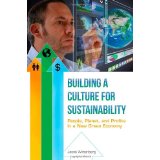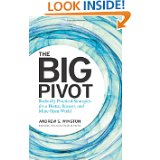by Alison Lueders
From sustainability to employee engagement to profitability
Research shows that sustainable business initiatives create more engaged (happier) employees, which lead to more profitable companies. Specifically:
- Gallup research shows that companies with more engaged employees are more profitable.
- Research from Harvard Business School shows that “sustainability initiatives are highly appealing to employees.” At Caesar’s Entertainment, for example, “customer loyalty and satisfaction – their overall experience and willingness to return to one of its hotels or casinos– is directly linked to employees’ level of participation in sustainable activities at work.”
But how?

Building a Culture for Sustainability profiles 9 companies.
Companies often struggle with the “how.” How do you build a culture for sustainability in your particular company? Jeana Wirtenberg’s new book, “Building a Culture for Sustainability,” helps answer that question.
She spent 2 years profiling 9 companies in depth about their sustainability programs and practices. These are not “the usual suspects” like Whole Foods or Patagonia. These companies are big guys who have been around, in some cases, for over 100 years. They want to become more sustainable, but have a lot of history and baggage to deal with.
Culture is key
The list below captures just 1 program or practice from each company. It doesn’t do justice to the full book, but it may persuade you to take a peek. If your business is in one of the industries covered, read that chapter. Better yet, pick a company in an industry different from yours. It’s an easy way to get a fresh perspective for your own sustainability journey.
- Alcatel Lucent is a telecom company built on the proud history of Bell Labs. They embrace a “triple bottom line” approach to business. To reach their sustainability goals, they organized “Green Touch” – a consortium of telecom companies whose goal is to make the global network “1000 times more energy-efficient by 2015.” To do that, companies share data that used to be proprietary. Cross-company collaboration is essential to get us where we need to go, and it’s a big culture change for many.
- Alcoa mines and manufactures aluminum – the “infinitely recyclable metal.” Alcoa has a “measurement culture.” Their A3 process – “assess, aspire, act” – is used to measure all kinds programs, not just sustainability ones. As Laurie Roy, HR director said, ” If you’re not measuring it, how do you know you are making progress?” Setting science-based goals, and measuring progress towards them is a key element of a sustainable culture.
- BASF is a company that believes “chemistry is what enables the transition to a sustainable society.” For example, they developed Green Sense concrete mixtures, which save water, energy and CO2 emissions compared to conventional concrete. This material is used, among other places, in the Freedom Tower in New York City. Sustainability is integral to their business – not bolted on to the side.
- Bureau Veritas is a world leader in testing, inspection and certification in over 140 countries. Their work with clients inspires them to reduce their own environmental footprint through energy, water and energy conservation programs. In addition, safety is ” not a priority, but an absolute.” That means 100% of employees receive ongoing training and communication about safety issues. From working safely at heights to safe driving, the focus is on prevention.
- Church & Dwight owns Arm & Hammer (the baking soda people) and a variety of other brands. They’ve been using 100% recycled board in their baking soda boxes for more than 100 years. They also offer full ingredient disclosure on many of their consumer products – a kind of transparency that truly sustainable companies will embrace.
- Ingersoll Rand has been in business for over 140 years. It’s a family of brands including Schlage and Trane. They’ve had great success building a sustainable culture using Green Teams. The number of teams doubled from 25 in 2010 to 52 in 2011 and doubled again to 110 in 2012. Each team focuses on improving their own facility’s environmental performance and on educating colleagues on “triple bottom line” issues. Locations with Green Teams have higher employee engagement scores than locations without Green Teams. ‘Nuf said.
- Pfizer is a global health care company. Their Global Health Fellows program places employees in 3 to 6 month stints abroad. This donation of people-expertise to countries with little to no health infrastructure builds trust in international communities. The Fellows get first-hand knowledge of areas where Pfizer can tweak its business model to better serve local people. And Pfizer builds employee engagement by offering this very popular program, where numbers of applicants far outstrip the number of slots.
- Sanofi is another health care giant. When you “put the patient first,” it’s a short step to seeing how sustainability supports that goal. Sanofi estimates that “13 million deaths can be prevented each year by safeguarding our environment.” Their CSR Ambassador Program enables employees from any department to volunteer for this role. Ambassadors learn about sustainability from in-house experts, and share that knowledge with colleagues. At Sanofi, this peer-to-peer approach is taking off.
- Wyndham Worldwide – This global hospitality company has a program called “Caught Green Handed.” It’s a recognition program that started in one business unit and spread to all the rest. Employees receive a certificate with their name and a description of their green contribution. This kind of program energizes employees and helps get the word out to others.
A treasure trove of examples
There are many ways to build a culture of sustainability. If you want your business to perform well into the future, sustainability is your path to superior results.
Building a sustainable culture is not about annual events and lip service. It’s about tapping into the power of all your people to re-imagine the core of your business in sustainable ways. That’s an exciting mission for people at all levels.
So if your company is struggling with the “how,” grab a copy of Ms. Wirtenberg’s book. It offers detailed examples of what companies are doing. It is also frank about the challenges they’ve faced. These companies don’t have some secret sauce that makes the transition to green easy. But you can learn from the road they’ve already traveled, and build a sustainable culture that suits your organization.


